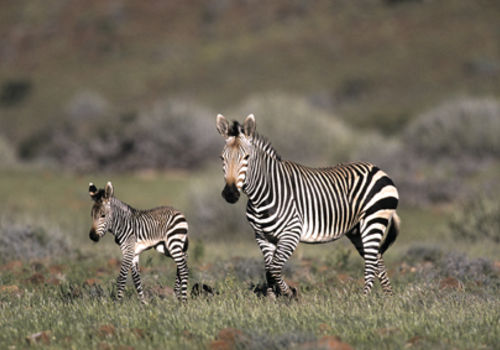
Hartmans zebra
Equus zebra hartmannaeHartmans zebra
Introduction: The name Hartmann's has been retained for this subspecies to distinguish it from the Cape mountain zebra. They are slightly larger than the Cape zebra. Other characteristics of the Hartmann's mountain zebra include:
The hooves grow extremely fast to compensate for the heavy wear endured on the rocky terrain on which they live. This species seeks shade and rests during the hottest parts of the day and has been demonstrated to orient its body with respect to the sun. The vocalizations of the Hartmann's zebra are similar to the neigh of a horse. Each zebra has an individual stripe pattern. After birth, the mare positions herself between the foal and the rest of the herd while it studies her stripes for future recognition. Zebras stay in family groups of a stallion, or male, and several mares, but different families will come together in huge herds of hundreds of zebras.
Distribution: The Hartmann's mountain zebra occupies the rugged, broken terrain on the plateau east of the Namib Desert, they can also be found in the western areas of Etosha National Park, in the area around Etosha Dolomite Camp.
Diet: Hartmann's mountain zebra are grazers and eat grass, leaves, bark, roots and stems. Where they are undisturbed, they may drink at any time of the day, but when they are regularly hunted, they water during the night. They will dig for water if it is not available and this movement is carried out with a scraping motion of the front hooves. This accommodates smaller mammals and birds whose survival depends on these actions.
Colouring: Hartmann's mountain zebra have broad black stripes on an off-white body. The stripes extend down the legs to narrow hooves, but do not meet on the belly. The mane is short, erect and bristle-like.
Breeding: Gestation period is around 362 days and the survival rate for foals is high, probably due to the protection offered to the young by other members of the group. Leopards, cheetah and drought are the foals' greatest enemy.
Size: An adult male stands about 150cm at the shoulder with ears 50cm long and ears 28cm long. Males weigh around 298 - 336kg and females 276kg.
Klein Windhoek

